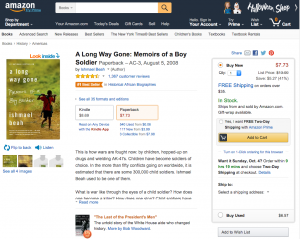Gillian Whitlock challenged readers to take a look at the “packages of life narrative” at bookstores and analyze the outer layer of the book (Whitlock describes this as the covers, introductions, acknowledgements, dedications, and blurbs). According to her, the outer layer of a life narrative says a lot about the book and even adds a whole new depth to its story. So I decided to take a look at one.
The book I decided to take a look at is a memoir by Ishmael Beah called A Long Way Gone: Memoirs of a Boy Soldier. Beah tells the first-person account of a Sierra Leonean boy who experienced combat as a child soldier in the Sierra Leone Civil War and struggled to recover from the experience. I read this memoir a while back, and wanted to dig deeper into it so I decided to look it up online on Amazon.com.
The first thing that caught me was the easily recognizable cover art. It’s a photo of a kid, maybe around the age of 12 walking with an AK47 slung over his back and a RPG round on his shoulders. I remember feeling strange the first time I picked the book up: a kid this young shouldn’t be carrying these things and he didn’t look happy doing this either. The cover immediately made me want to know the story behind this kid. Next, I read the summary for the book. The summary had the overall context of the conflict that took place in Sierra Leone. It mentioned that “300,000 child soldiers” were used and that “Ishmael Beah used to be one of them”. It also mentions that “until now, there has not been a first-person account” on this issue, which intrigued me.
All of this (the title, cover, and summary) works to draw potential readers to buy this book. It makes people feel sympathy and are intrigued at the same time, drawing them into wanting to know more about this “boy soldier”. Whitlock in We Shall Bear Witness mentions that the brutality and realism of testimony makes people want to take action for a particular cause. In the case of this memoir, the potential reader sees the outside of the book and decides (without reading it yet) to take action and learn more about the child soldier phenomenon. This action taken by the reader will help spread awareness on the topic as well as work to “further a cause”. Although the content of a life narrative works to tell a story and raise awareness, it is important to also note how the book is presented at retail centers to really understand its purpose.
